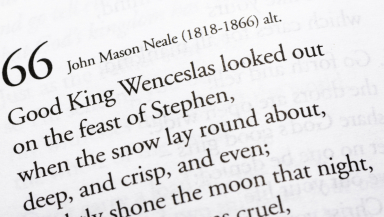
Every Christmas, carol singers sing the song of Good King Wenceslas. But who was he? This is the story ...
The carol
According to the lyrics "Good King Wenceslas last looked out on the Feast of Stephen", the king and his page face the snowy weather to give alms to a poor peasant. Along the way the page is about to give up the struggle against the cold weather, but is enabled to continue by following the king's footprints through the deep snow. The song was published in 1853, and with its strong tune and lyrics has been a favourite ever since, but few know the story behind it.
The writer
The song was penned by the Rev John Mason Neale (1818-1866) who was an Anglican priest. He was named after the Puritan cleric John Mason (1645-94), who he was descended from. However, he was not a Puritan himself but prefered the Anglo-Catholic tradition, and he was very interested in old Catholic and Eastern Orthodox traditions. He also loved poetry. When he was a student at Trinity College, Cambridge, he won the Seatonian prize for religious poetry many times. He was ordained in 1842, and spent the last twenty years of his life as a warden of Sackville College, which were almshouses for retired poor men at East Grinstead in West Sussex in southern England. He translated a number of hymns and liturgies from Latin and Greek into English. Two songs he translated are still popular at Christmas time today - the Advent hymn "O come, O come, Emmanuel" which he translated from Latin, and "Good King Wenceslas".
Who was King Wenceslas?
For English speakers the name Wenceslas sounds distinctly foreign and unusual. The song tells the story of the tenth century saint, who despite the lyrics, was neither a king nor even called Wenceslas. Wenceslas's real name was actually Václav (c 907-935) and he was Czech and the Duke of Bohemia, from the Přemyslid dynasty.
The background to the story is that from AD 863, the Slavs of Bohemia and Moravia (now the Czech Republic) had been converted to Christianity by Saints Cyril and Methodius who brought Christianity to the Slavs of Eastern Europe, and translated the Bible into Slavonic. The Slavonic language had not been written down before, and they had to create an alphabet to do so. The Cyrillic alphabet is named after St Cyril.
Václav was raised as a Christian, thanks to his grandmother St Ludmila (c 860-921), who had been converted and baptised by Saints Cyril and Methodius. Like the queen mothers of the Bible, she acted as his regent until he was old enough to rule.
Václav had a loyal and faithful Christian page called Podevin. They did many charitable works together, comforting the sick, the poor, widows and orphans. They were dedicated to sheltering the homeless and buying the freedom of slave children.
Death
On 28th September AD 935, Václav was stabbed to death, believed to be on the orders of his own jealous brother Boleslav. According to tradition his loyal and faithful page Podevin avenged his death by killing one of the assassins. After his death, many stories were recalled, or possibly invented about him. He was canonised in AD 938, and his remains are buried in the Saint Wenceslas Chapel of Saint Vitus Cathedral at Prague Castle. As a saint and martyr, hagiographies were written extolling his reputation as a man of virtue and he was known as Václav the Good. Svatý Václav (St Wenceslas) soon became the patron saint of the Czechs, and 28 September became St Wenceslas Day, and a national day for the Czechs.
The name Václav was Latinised as Wenceslaus or Wenceslas, and Otto I, who was Holy Roman Emperor from 962 to 973, posthumously raised him to the rank of king. And so it was the 'Duke Václav the Good', became the 'Good King Wenceslas' in literature.
The writing of the carol
This story interested John Mason Neale, who loved Eastern European Christian history, and as a warden of an almshouse was interested in helping the poor. Neale was inspired by songs and poems about Svatý Václav. In 1849, he first published the story of Wenceslas and his page (who he called Otto) in "Deeds of Faith: Stories for Children from Church History". He then adapted a sixteenth century text in a German manuscript about Wenceslas and his page Podevin, and put them to rhyme in English. He set the song to a 13th-century tune called 'Tempus adest floridum' (translated as 'The Time Is Near For Flowering'), which was actually an Easter hymn.
So while the song sounds like an ancient mediaeval song, written in archaic English, and is sometimes labelled as "traditional", it is actually Victorian. It was first published in "Carols for Christmas-Tide" published by Novello & Co in 1853.
Today it is one of the most popular Christmas carols, which unusually has no explicit biblical references and no references to the Nativity at all. The link with Christmas is simply that the carol is set on "the Feast of Stephen" which is December 26, the day after Christmas Day. This was the day when traditionally people gave boxes of gifts to the poor or to their servants, and hence it became known in Britain as Boxing Day.
St Wenceslas today
Svatý Václav became a national Czech hero and legends arose about him. Anyone who has been to Prague will have seen the large statue of Svatý Václav (St Wenceslas) on a horse in Václavské náměstí (Wencelsas Square) in central Prague, which has stood there since 1913. At various points in Czech history the statue and square have been the focus of demonstrations for Czech freedom, especially in 1968 and 1989, and often memorials and wreaths and candles are lain at the base of the statue. In 1918 this was a good day and the Wenceslas statue was a good place to declare the independence of Czechoslovakia, and so since 2000 it has been a public holiday in the Czech Republic.
The carol's message
The carol concludes with a reminder that as Christians we should also be kind to the poor, which echoes Proverbs 19:17 and Matthew 25:31-46: "Therefore, Christian men, be sure, wealth or rank possessing, Ye who now will bless the poor, shall yourselves find blessing."













